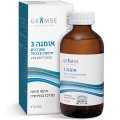By Elaine Munro
Glutamine - The Healing Protein
Often, we don't see, or take for granted, things that are right in front of us. Glutamine is one of those things.
Have you ever watched someone looking for ketchup in the fridge? The door is wide open, and it's sitting there on the shelf, but they can't see it. Often, we don't see, or take for granted, things that are right in front of us. Glutamine is one of those things.
Glutamine is a protein (part of the macronutrient group) that is produced by a conversion process in skeletal muscle and the liver. The body takes a non-essential amino acid, glutamic acid, and adds an additional nitrogen atom. Glutamine is the most abundant amino acid in the body. However, in stressed, injured or active individuals, demand can outweigh supply. An amazing variety of body functions depend on, or are improved by, abundant supplies of glutamine.
Immune Function
Glutamine supports the natural synthesis of our key antioxidant and immune-boosting chemical,1 glutathione, which provides general disease-fighting insurance. It also helps to prevent pathogens from entering the system, primarily through the intestinal wall.
Intestinal Healer
Glutamine is the key protein for ensuring intestinal health,2 It is the primary material for regenerating the intestinal lining. When the lining is healthy, it allows nutrients to pass into the blood stream and prevents toxins from entering the system. If availability of glutamine is low in conjunction with conditions such as irritable bowel syndrome, celiac or Crohn's disease,3 then skeletal muscle tissue is utilized. This creates a cascade of problems, including slowed metabolism and an increased tendency to store body fat.
Muscle Repair
There are two principal functions of glutamine in muscle tissue. It is the most abundant free-form protein in muscle, comprising approximately 50 percent of the amino acid structures. As tissue is damaged, due to stress (illness and emotional) or exertion (exercise), higher levels of glutamine are required for repair.4 Glutamine also protects muscle tissue from cortisol, a hormone released from the adrenal glands as a result of exertion or stress. Cortisol attaches itself to muscle cell receptor sites and consumes the tissue. Glutamine acts as a protective barrier for the muscle tissue.
An ideal time to take glutamine is before bed. Glutamine supports the natural release of human growth hormone, supporting skeletal muscle repair and overall cellular recovery-an important anti-aging property.
Brain Function
Glutamine is also an abundant protein in the fluid surrounding the brain and spine (cerebrospinal fluid). It is an important precursor to key neurotransmitters that send impulses in the brain and to nervous system tissue throughout the body. Studies show that glutamine helps in addiction recovery and functions as an antidepressant.5,6
Sources of Glutamine
Glutamine-rich foods include fish, meat, dairy, grains, and beans. Glutamine supplements are usually derived from the protein in whey or wheat. There are two forms that are generally available: l-glutamine (the free-form amino acid) and glutamine peptides (partially digested).
L-glutamine, although it is the purest form of supplemental glutamine, is less stable to store over time. It should be kept in a cool, dark location. Since l-glutamine can elevate ammonia levels in the body, it should be used in small amounts (2 to 4 g) throughout the day. Glutamine peptides are more easily digested, although they have a distinctive taste.
Either l-glutamine or glutamine peptides, or combinations of both, provides significant building blocks for healing. The normal dosage is from 2 to 20 grams per day, and levels of even 40 grams per day show no negative side effects.
Key to Healing
We know that protein plays a critical role in the ongoing cellular recovery of our bodies. The range and subtleties of that healing become amazing when we look at the role of glutamine. It is one of the body's most important building blocks of health.
References
1. Alverdy, J.C. "Effects of Glutamine-Supplemented Diets on Immunology of the Gut" JPEN 14(1990):109S-113S
2. Hartman, F., M. Plaath. "Intestinal Glutamine Metabolism" Metabolism 38 (suppl 1) (1989):18-24
3. Fox, A.D., et al. "Effects of Glutamine-Supplemented Enteral Diet on Methotrexate-Induced Enterocolitis" JPEN 12 (1987):43-44.
4. Stehle, P., et al. "Effects of Parenteral Glutamine Peptide Supplements on Muscle Glutamine Loss and Nitrogen Balance After Major Surgery." Lancet I (1987):231-233
5. Cocchi, R. "Antidepressive Properties of L-Glutamine." Acta Psychiatr Belg 76 (1976):658-666
6. Young, L.S., et al. "Patients Receiveing Glutamine Supplemented Intravenous Feedings Report an Improvement in Mood" JPEN 17 (1993):422-427
Source: www.vistamagonline.com
